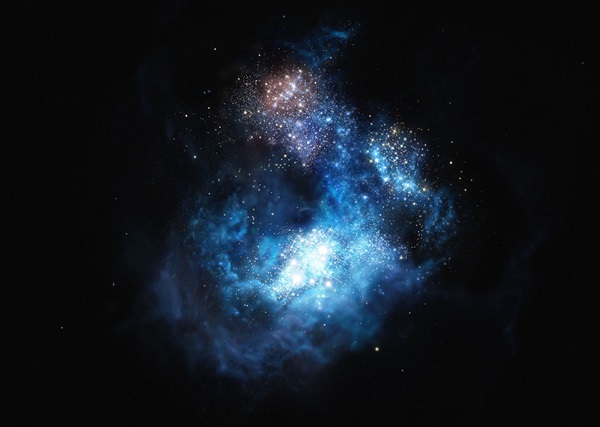Key Takeaways:
Unlike their stellar-sized cousins, which form following the collapse of a massive star, the supermassive black holes at the centers of galaxies are simply too large to result from a single star’s death. Even with the recent confirmation of intermediate-mass black holes, the mystery hasn’t been solved. As astronomers eagerly await new observations that the launch of the James Webb Space Telescope will finally make possible, they continue developing theories to explain these mysterious objects.
Supermassive black holes (SMBHs) tip the scales at hundreds of thousands to billions of solar masses. Sgr A*, the supermassive black hole at the center of the Milky Way, is about 4.5 million times the mass of the Sun. The formation of such “lower-mass” SMBHs (a few million solar masses) is imagined to occur following the formation of a “seed” black hole of about 100 solar masses. A black hole of this size is feasible following the collapse of an extremely massive star. Over time, that seed accretes matter and possibly even merges with other nearby seeds, building into the million-solar mass black holes we see today.
But the SMBHs powering young, distant quasars in the early universe can’t be explained this way. In a letter published in the March 13 issue of Nature Astronomy, John Regan of the Institute for Computational Cosmology at Durham University in the United Kingdom and his coauthors describe their model for the early-universe circumstances that could lead to the creation of direct-collapse black holes (DCBHs). Direct-collapse black holes are a unique type of black hole that requires essentially perfect environmental conditions to form — conditions that only exist in the early universe.
Quasars are really the accretion disks around a supermassive black hole; during a galaxy’s earliest years, such an accretion disk can grow so massive that it outshines the rest of the galaxy altogether, and astronomers identify it as a quasar. The black hole at the center of a quasar is already massive —millions or billions of times the mass of the Sun. But in the young universe, there simply hasn’t been time for accretion and mergers to make a supermassive black hole this big. Furthermore, any first-generation star large enough to form a quasar seed black hole would have enormously powerful stellar winds, blowing away gas and dust from around itself and choking off its ability to accrete matter quickly once the black hole is formed.
DCBHs could be the mechanism responsible for powering distant quasars because they don’t require fuel or time to grow from something small into something large. Instead, they form at large initial masses when gas inside the galaxy collapses directly into a black hole with no stages in between, hence their name. If the gas inside a forming galaxy is heated but not allowed to cool, and then compressed by a dark matter halo, the conditions may be just right to form a direct-collapse black hole. The idea was first put forth in 2003 by Volker Bromm and Avi Loeb, and possible evidence for this type of black hole was found in 2016 with observations of a galaxy called CR7.
Now, Regan and his group have developed simulations to determine whether interactions between neighboring protogalaxies as galaxies cluster together could spark DCBH formation. When gas is heated inside a galaxy, it typically “cools” via one of several processes, the most common of which are star formation and the emission of energy from metals (in astronomy, anything heavier than helium is called a “metal,” and is formed inside the core of a massive star). The trick to creating a DCBH is getting the gas to collapse without allowing these cooling processes to occur.
Following several simulations, Regan’s group found a “sweet spot” in which heating from the background radiation associated with the clustering of galaxies, coupled with a starburst (a period of very rapid, widespread star formation) in a nearby protogalaxy, could lead to the formation of a DCBH.
There are several conditions that must be met. Black hole formation is most likely when the pair of galaxies is separated by a distance between 200 and 300 parsecs (650-1,000 light-years). If the galaxies are too close, the starburst could knock apart the atoms in the galaxy’s gas molecules or simply blow the gas away. A close-by starburst could also “pollute” its fellow galaxies with metals blown out by its supernovae; the metals would then cool the gas and allow it to fragment into stars (rather than form a DCBH). But if the galaxies are too far apart, they simply don’t interact energetically or quickly enough for the starburst to influence its neighbors.
Additionally, the timescale of the starburst must “synchronize” closely with the timescale of star formation in neighboring protogalaxies. If the starburst happens at the wrong time, the neighboring galaxies will already have begun to form stars and the conditions for a DCBH won’t be met. The ideal time for a starburst to turn on is about 4 million years before stars would have otherwise begun forming in its neighbors. But if the starburst happens more than 10 million years before star formation would have started, it won’t have the right effect, either. A starburst that lasts too long will adversely affect its neighbors via metal pollution or overly energetic radiation.
The results of these simulations aim to give astronomers evidence to look for when Webb finally comes online. Regan and his co-authors state that observing close pairs of young protogalaxies with the new space telescope could provide the data necessary to prove their DCBH formation scenario right.










